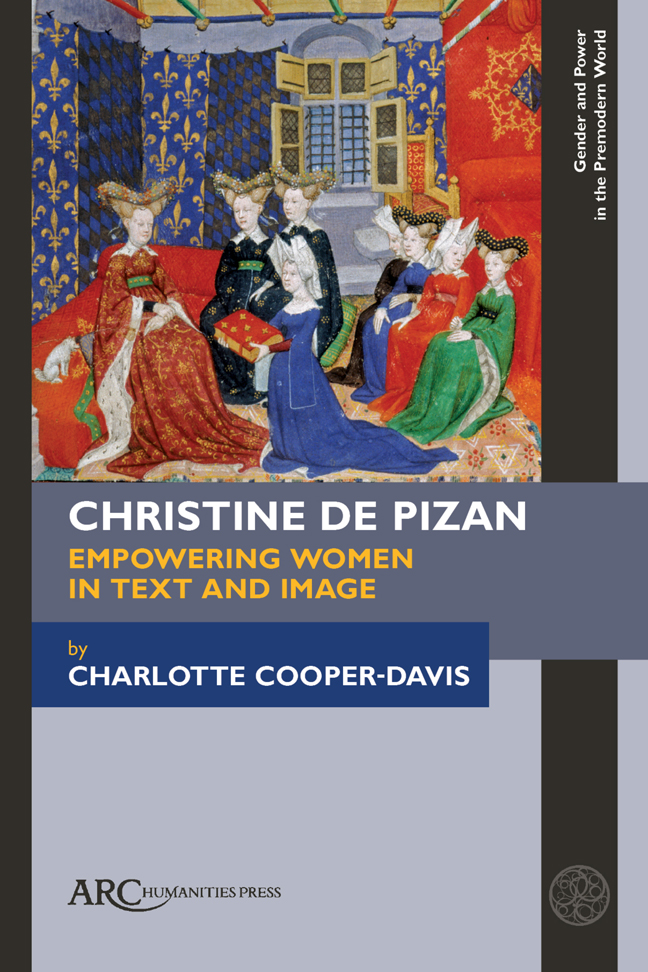Book contents
- Frontmatter
- Dedication
- Contents
- List of Illustrations
- Acknowledgements
- Abbreviations
- Note on Translation
- Introduction
- Chapter 1 Conventions, Collaboration, and Craft: Representing the Author in Christine de Pizan's Author-Manuscripts
- Chapter 2 Wisdom, Chastity, and War: The Power of Female Didactic Figures
- Chapter 3 Female Creation and Education in Le Livre de la mutacion de Fortune
- Chapter 4 Assessing the Gender of Christine's Audiences
- Conclusion
- Christine de Pizan's Illustrated Author-Manuscripts
- Bibliography
- Index
Chapter 1 - Conventions, Collaboration, and Craft: Representing the Author in Christine de Pizan's Author-Manuscripts
Published online by Cambridge University Press: 20 February 2024
- Frontmatter
- Dedication
- Contents
- List of Illustrations
- Acknowledgements
- Abbreviations
- Note on Translation
- Introduction
- Chapter 1 Conventions, Collaboration, and Craft: Representing the Author in Christine de Pizan's Author-Manuscripts
- Chapter 2 Wisdom, Chastity, and War: The Power of Female Didactic Figures
- Chapter 3 Female Creation and Education in Le Livre de la mutacion de Fortune
- Chapter 4 Assessing the Gender of Christine's Audiences
- Conclusion
- Christine de Pizan's Illustrated Author-Manuscripts
- Bibliography
- Index
Summary
Like a text, an image acquires authority through repetition.
IN THE INTRODUCTION, the premise was put forward that images are central to our understanding of Christine de Pizan's texts and that they play a key role in setting up the concept of authority as a form of power. The purpose of this chapter is to how representations of Christine in her author-manuscripts served to empower her and underscore her authority. In other words, this chapter investigates the various conduits that contribute towards envisioning a powerful author figure.
Those who see one of Christine's author-portraits might be forgiven for assuming that, because she is often represented in blue, she is visually associated with the Virgin Mary – arguably the most powerful artistic representation of a woman in the Middle Ages. However, this statement is not entirely true, since, contrary to popular and even scholarly opinion, Christine was not always represented in this manner. In fact, we shall see that only one artist did so with consistency. What this means is that where she is depicted in the “Marian blue” hue with which she is now commonly associated, it is endowed with particular significance. This chapter considers the various factors that led to this representation of Christine becoming “standardized” in the minds of viewers and readers and, over time, in Christine's author-manuscripts themselves. This includes an examination of the influence of and motivations for using the Marian model and the symbolic charge it carries. A key feature of Christine's author-portraits is that details from their visual programs are consistently repeated and reused, creating cohesion throughout and between manuscripts and copies of her works. As Desmond suggests in the quotation with which this chapter opens, the repetition of an image of this kind inevitably generates authority for Christine by implying that she was significant enough to have her likeness reproduced across different volumes, and thus adds to the power of her messages.
There is more to be said about how Christine gains power through her author-portraits, but before doing so it is necessary to first explore the concept of “author-portrait” and its association with authority. Consequently, the discussion of representations of Christine begins with a brief consideration of these terms, along with some wider contextual detail concerning the creation of portraits in the Middle Ages.
- Type
- Chapter
- Information
- Christine de Pizan Empowering Women in Text and Image , pp. 25 - 62Publisher: Amsterdam University PressPrint publication year: 2023



